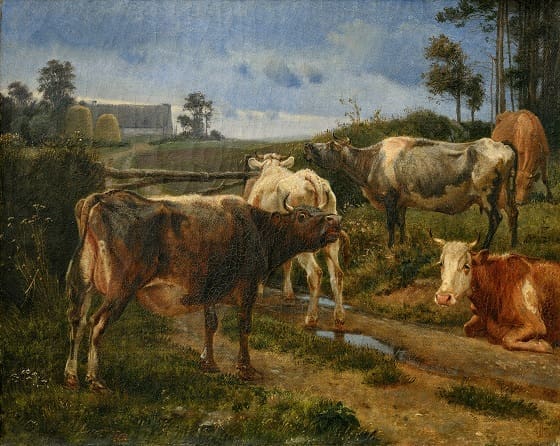J. Th. Lundbye
Bellowing cows by the fence gate, 1847
Oil on canvas, 33 x 41 cm.
Inventory number: 0093NMK
Bequest from Vilhelmine and Alfred Hage, 1891. Bestowed to the museum in 1908
Four cows have gathered by a closed gate on a chilly autumn evening. A road from the pen trails through the flat landscape to a farmhouse. Dark clouds have fanned across the evening sky and are about to engulf the last rays of the sunset. After returning from his stay in Italy, Lundbye once again went back to travelling around Zealand painting scenes from Denmark’s nature and peasant life. In this painting, he has drawn inspiration from the Dutch animal painter Paulus Potter, whose works could be found at the Royal Collection of Paintings (known today as the National Gallery of Denmark). Lundbye was a great admirer of the Dutch Golden Age painter’s both precise and lifelike rendering of cows in particular, and closely studied several of his animal paintings during his brief stay at The Hague in the year prior to the painting of this work.
Johan Thomas Lundbye (1818-1848)
Lundbye belongs to the youngest generation of Danish Golden Age painters. His speciality was painting animals, but it was his landscape paintings that defined his career. Influenced by the Royal Danish Academy of Art professor J.L. Lund among others, Lundbye adopted a Romanticist approach to art early on. His paintings were far more atmospheric than those of other Golden Age painters such as C.W. Eckersberg and his students. He was accordingly one of the artists who helped engender the breakthrough of National Romanticist landscape painting, which earned him no small amount of accolade during his time. Lundbye was very interested in literature, finding inspiration for his paintings among the works of writers such as Søren Kierkegaard. He voluntarily signed up to fight in the First Schleswig War in 1848, but it is generally believed that he was killed by an accidental shot before he had the chance to fight in an actual battle.


